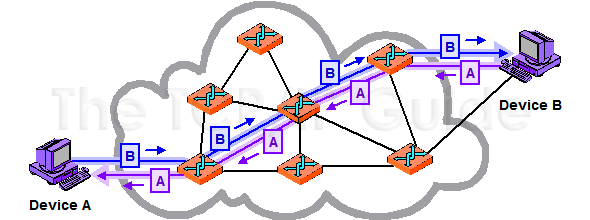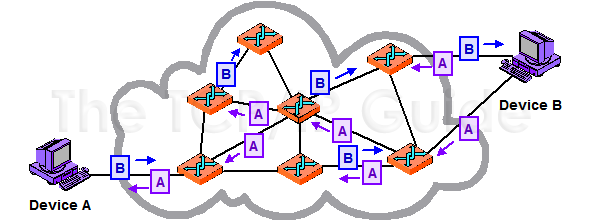from:http://www.tcpipguide.com/free/t_CircuitSwitchingandPacketSwitchingNetworks.htm
Circuit Switching and Packet Switching Networks
(Page 1 of 3)
In my “grand overview” of networking, I describe networks as devices that are connected together using special hardware and software, to allow them to exchange information. The most important word in that sentence is the final one: information. As you will see in your exploration of this Guide, there are many methods for exchanging information between networked devices. There are also a number of ways of categorizing and describing these methods and the types of networks that use them.
One fundamental way of differentiating networking technologies is on the basis of the method they use to determine the path between devices over which information will flow. In highly simplified terms, there are two approaches: either a path can be set up between the devices in advance, or the data can be sent as individual data elements over a variable path.
Circuit Switching
In this networking method, a connection called a circuit is set up between two devices, which is used for the whole communication. Information about the nature of the circuit is maintained by the network. The circuit may either be a fixed one that is always present, or it may be a circuit that is created on an as-needed basis. Even if many potential paths through intermediate devices may exist between the two devices communicating, only one will be used for any given dialog. This is illustrated in Figure 1.
Figure 1: Circuit Switching
In a circuit-switched network, before communication can occur between two devices, a circuit is established between them. This is shown as a thick blue line for the conduit of data from Device A to Device B, and a matching purple line from B back to A. Once set up, all communication between these devices takes place over this circuit, even though there are other possible ways that data could conceivably be passed over the network of devices between them. Contrast this diagram to Figure 2.
| 
|
The classic example of a circuit-switched network is the telephone system. When you call someone and they answer, you establish a circuit connection and can pass data between you, in a steady stream if desired. That circuit functions the same way regardless of how many intermediate devices are used to carry your voice. You use it for as long as you need it, and then terminate the circuit. The next time you call, you get a new circuit, which may (probably will) use different hardware than the first circuit did, depending on what's available at that time in the network.
Packet Switching
In this network type, no specific path is used for data transfer. Instead, the data is chopped up into small pieces called packets and sent over the network. The packets can be routed, combined or fragmented, as required to get them to their eventual destination. On the receiving end, the process is reversed—the data is read from the packets and re-assembled into the form of the original data. A packet-switched network is more analogous to the postal system than it is to the telephone system (though the comparison isn't perfect.) An example is shown in Figure 2.
 Key Concept: One way that networking technologies are categorized is based on the path used to carry data between devices. In circuit switching, a circuit is first established and then used to carry all data between devices. In packet switching no fixed path is created between devices that communicate; it is broken into packets, each of which may take a separate path from sender to recipient.
Key Concept: One way that networking technologies are categorized is based on the path used to carry data between devices. In circuit switching, a circuit is first established and then used to carry all data between devices. In packet switching no fixed path is created between devices that communicate; it is broken into packets, each of which may take a separate path from sender to recipient.
Figure 2: Packet Switching
In a packet-switched network, no circuit is set up prior to sending data between devices. Blocks of data, even from the same file or communication, may take any number of paths as it journeys from one device to another. Compare this to Figure 1
Comparing Circuit Switching and Packet Switching
A common temptation when considering alternatives such as these is to ask which is “better”—and as usually is the case, the answer is “neither”. There are places where one is more suited than the other, but if one were clearly superior, both methods wouldn't be used.
One important issue in selecting a switching method is whether the network medium is shared or dedicated. Your phone line can be used for establishing a circuit because you are the only one who can use it—assuming you can keep that pesky wife/husband/child/sister/brother/father/mother off the phone.
However, this doesn't work well in LANs, which typically use a single shared medium and baseband signaling. If two devices were to establish a connection, they would “lock out” all the other devices for a long period of time. It makes more sense to chop the data into small pieces and send them one at a time. Then, if two other devices want to communicate, their packets can be interspersed and everyone can share the network.
The ability to have many devices communicate simultaneously without dedicated data paths is one reason why packet switching is becoming predominant today. However, there are some disadvantages of packet switching compared to circuit switching. One is that since all data does not take the same, predictable path between devices, it is possible that some pieces of data may get lost in transit, or show up in the incorrect order. In some situations this does not matter, while in others it is very important indeed.
While the theoretical difference between circuit and packet switching is pretty clear-cut, understanding how they are used is a bit more complicated. One of the major issues is that in modern networks, they are often combined. For example, suppose you connect to the Internet using a dial-up modem. You will be using IP datagrams (packets) to carry higher-layer data, but it will be over the circuit-switched telephone network. Yet the data may be sent over the telephone system in digital packetized form. So in some ways, both circuit switching and packet switching are being used concurrently.
Another issue is the relationship between circuit and packet switching, and whether a technology is connection-oriented or connectionless. The two concepts are related but not the same; the next topic discusses this in much more detail.
Note: Note that the word “packet” is only one of several terms that are used to refer to messages that are sent over a network. Other terms you will encounter include frame, datagram, cell and segment.
| |
| 
|
 Key Concept: One way that networking technologies are categorized is based on the path used to carry data between devices. In circuit switching, a circuit is first established and then used to carry all data between devices. In packet switching no fixed path is created between devices that communicate; it is broken into packets, each of which may take a separate path from sender to recipient.
Key Concept: One way that networking technologies are categorized is based on the path used to carry data between devices. In circuit switching, a circuit is first established and then used to carry all data between devices. In packet switching no fixed path is created between devices that communicate; it is broken into packets, each of which may take a separate path from sender to recipient.
